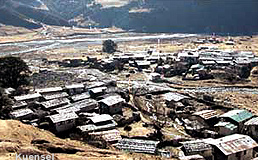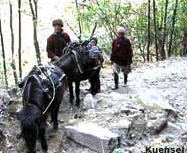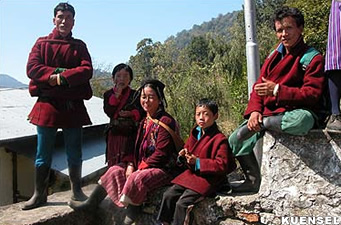| Bhutan
- Ethnic Groups & People |
 |
Bhutan People Merak - Sakten |
|
 |
Bhutan Information |
|
|
 |
|
Sakten (Sakteng):
Leaving the cold behind
|

|
 |
| Sakten village |
|
Smoke
rises from few of the houses clustered in the gently sloping valley, cupped
by hills on all sides. On the dry sallow slopes above the valley, yaks
graze, their harness bells softy breaking the silence.
Sakten,
Trashigang dzongkhag's northernmost geog and home of the Brokpas, a nomadic
community, looks deserted.
|
|
Except
for a few elderly people of the community, the young and fit have locked
their shingled roofed stone houses and, as is customary every winter, migrated
to the warmer valleys with their cattle and food stock.
According
to dungkhag officials, Sakten has about 300 households and a population
of about 1,500 people. But during winter less than 100 people live
in the settlement of closely clustered houses that have just enough space
in-between for people and cattle to pass through.
 |
|
"Most
families who don't have much property lock their houses and leave early
to look for a place in the lowlands while a few well off ones keep some
old men and women to look after their houses," said the Sakten Mangi ap
Sangay Dorji. "The wealthy families give the caretaker rice and money when
they return," he said.
The
few who stay home throughout the year are normally those who are too old
to walk, the shopkeepers and the dungkhag officials who stay back to keep
the office running.
|
|
The students in Namgaychholing lobdra, the only Buddhist
school in Sakten, which educates and provides food and shelter to many
poor Merak and Sakten orphans also stay back.
Since
nothing grows in winter the few people staying in Sakten don't have much
work to do. As night falls, most residents retire to bed by seven pm. "All
people do, is fetch firewood, water and drink ara all day," said Tshokpa
Dorji. "We survive on potatoes, radish, spinach and khali (millet) that we grow in summers."
 |
| Brokpa people |
|
Many
Saktenpas save khali for the winter months because it can be grounded into
powder to make local bread and local brew, the most popular diet in winter.
"Khali is normally sown in April when Saktenpas return home and is harvested
in August before they migrate," Tshokpa Dorji said. "But there are not
many villagers who can produce khali in abundance since it requires a lot
of hard work. |
|
Neither
is there butter nor cheese to sell as most of the cattle are in the lower
valleys. "Zeydey
or fermented cheese is the most popular product people buy at this time,"
said Tshokpa Dorji.
The
migrants have their own selected places in the lower valleys. Some groups
go down to Khelphug, some to Shingkharong, which is beyond Merak, and others
go to Thongrung in Phongmey.
The
nomads usually stay with their cattle in these places selling their products
in exchange for rice and other necessities like chillies, salt, sugar and
kerosene. The poorer ones with fewer cattle do other odd jobs in the towns
like working on roadsides for a daily wage of Nu.100. "The cattle are let
free in the wilderness to graze while the men spend time in carpentry and
fetching fire wood and the women milk the cattle and spin wool," said Mangi
Ap Dorji Sangay.
Women
usually engage themselves in weaving their traditional woollen dress. They
also milk the yak and the cheese they get from it is stored in hardened
leather bags for fermentation.
Before
snowfall, Saktenpas normally frequent Trashigang town during November
and December, to restock their ration for the cold winter months, which
lasts for three months. "After the snowfall the route gets covered with
snow and ice and we cannot move south," said Dema a Sakten resident. "We
barter our cheese and butter for rice. We also buy rice for our own consumption
and eat it sparingly."
Besides
Trashigang, the Brokpas also go to Tawang (border town of India),
which is located to the west of Sakten to sell the yak products in return
for clothes and other food items. According to a shopkeeper it is easier
to hike up to Tawang than Trashigang. "It takes just a day to reach Tawang
with horses while it takes about three days to reach Trashigang," said
the shopkeeper.
Merak
which lies to the south of Sakten is also home to the Brokpa community
and is a full day walk from Sakten on the opposite hill.
Contributed
by Samten Wangchuk, Kuensel
| more
information |
 |
|





